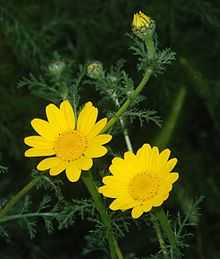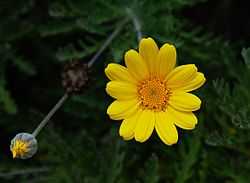Cota tinctoria
| Cota tinctoria | |
|---|---|
 | |
| Yellow Camomille (Cota tinctoria) | |
| Scientific classification | |
| Kingdom: | Plantae |
| (unranked): | Angiosperms |
| (unranked): | Eudicots |
| (unranked): | Asterids |
| Order: | Asterales |
| Family: | Asteraceae |
| Genus: | Cota |
| Species: | C. tinctoria |
| Binomial name | |
| Cota tinctoria (L.) J. Gay ex Guss. [1] | |
| Synonyms | |
|
Anthemis tinctoria L. (basionym) | |

Cota tinctoria (golden marguerite, yellow chamomile, oxeye chamomile), syn. Anthemis tinctoria, is a species of perennial flowering plant in the family Asteraceae. Other common names include "dyer's chamomile", "Boston daisy", "Paris daisy". In horticulture this plant is still widely referred to by its synonym Anthemis tinctoria.[2]
It is a short-lived plant often treated as biennial, occurring in the Mediterranean and western Asia. It has aromatic, bright green, feathery foliage. The serrate leaves are bi-pinnatifid (= finely divided) and downy beneath. It grows to a height of 60 cm.
It has yellow daisy-like terminal flowers on long thin angular stems, blooming in profusion during the summer.
It has no culinary or commercial uses and only limited medicinal uses. However, it produces excellent yellow, buff and golden-orange dyes, used in the past for fabrics.
Cota tinctoria is grown in gardens for its bright attractive flowers and fine lacy foliage; there is a white flowering form also but the most commonly grown form is the seed raised cultivar 'Kelwayi' which has 5 cm wide, yellow flowers on 65 cm plants. The asexually propagated cultivar 'E.C. Buxton' is a hybrid between this species and another Anthemis species.

References
| Wikimedia Commons has media related to Cota tinctoria. |